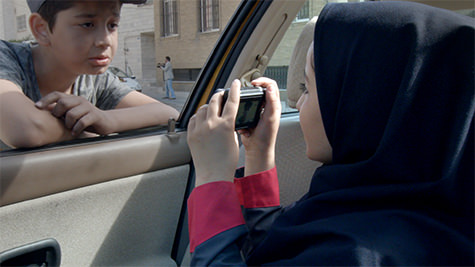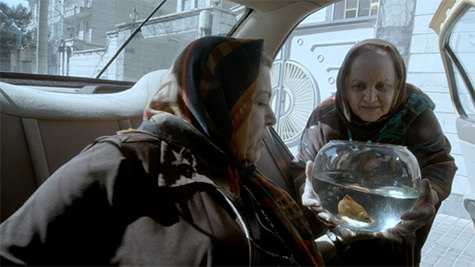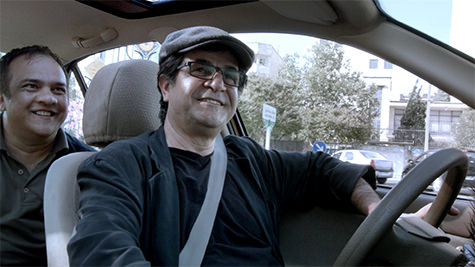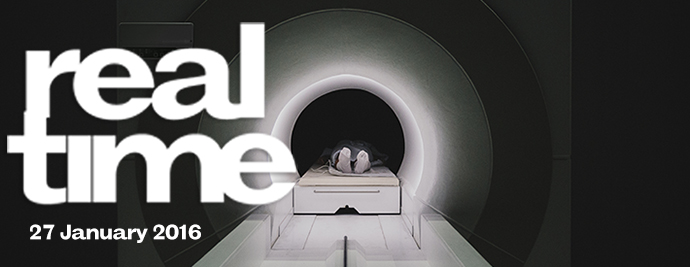Tehran Taxi opens with a dash-cam documentary shot of a busy intersection as the traffic streams by. It’s the kind of everyday street scene news images never show. Yet this impersonal, fly-on-the-dashboard perspective is quickly disrupted as the car stops and picks up a passenger—a man later described as an actor. Or is he? There’s a constant slippage here between constructed drama and the material real of the streets of Tehran—a slippage at the heart of Jafar Panahi’s cinema.
After he climbs on board, we hear the passenger off-camera ask the driver about the contraption on the dashboard. A hand turns the lens around, and the image is reframed on the passenger and another woman behind him, on the back seat. “It’s a kind of anti-theft device,” we hear the driver explain, with a line that becomes highly ironic by the end of the film.
The two travellers quickly become embroiled in a heated debate about a recent execution, a conversation typical of the incredibly lifelike exchanges that characterise Panahi’s dramas. For a moment this feels like ‘reality’ filmmaking, caught on the fly. Then they both alight, and any pretence of po-faced documentary realism collapses when a third, previously unseen passenger declares, “Mr Panahi, I knew it was you! I recognised you straight away!” He asks coyly, “Those guys were actors, right? Their dialogue was just like the one in your movie, Crimson Gold!” This may be a real cab moving through the streets of Tehran, but it’s one driven by Iran’s most famous dissident filmmaker. Inside he stages a series of in-jokes and miniature dramas seared by the world glimpsed through the windows.
 |
still from Tehran Taxi |
Tehran Taxi is the third instalment in Panahi’s “cinema of confinement”—a cycle of inventive and self-reflexive features shot following the director’s arrest in 2009 and his subsequent 20-year ban from filmmaking and overseas travel (see RT 107). Beginning with 2011’s This is Not a Film, Panahi has used small video cameras to both document and dramatise his attempts to keep working while living under these strictures. The results have been smuggled out of Iran and screened globally, even as he remains persona non grata at home.
Judging by the new film, the restrictions on Panahi’s daily existence have loosened somewhat since This is Not a Film, which was shot under conditions of virtual house arrest. In a nod to the classic Ten (1990) by his former mentor Abbas Kiarostami, Tehran Taxi is shot entirely from inside the eponymous vehicle, a conceit made possible by the miniaturised cameras of the digital age. Despite the constant driving across 82 minutes in which we never leave the cab, this is not a road movie. There is no destination and the journey itself is immaterial—most of the film is spent circling utterly nondescript streets. This car is certainly not a symbol of freedom.
Instead, Panahi utilises the taxi as an interface between public and private space—a mobile interior in which the filmmaker can construct his work as he moves through a public realm from which he is officially excluded. It’s an apt metaphor for the position of Iran’s opposition as they contest the regime’s control of public zones, and the policing of private lives, from concealed positions of muted resistance.
These contestations are reflected in the dialogues that play out in Panahi’s cab, to often-humorous effect. The passenger who ‘recognises’ the director, for example, is a peddler of pirate DVDs, plying his trade among Tehran cinephiles starved of foreign fare. He recognises Panahi because he once sold him some banned American movies. Blithely using the famous director’s presence to help unload some extra discs onto a starstruck client, the affable rogue takes offence when Panahi makes fun of his dubious business practices. “Without me,” he reminds the filmmaker, “No more Woody Allen, Mr Panahi!” In Iran, piracy has a political as well as economic dimension.
 |
still from Tehran Taxi |
In a more pointed interaction towards the end of the film, Panahi chats with his young niece, who has been asked to make a short film by her teacher. The film must be “screenable” the girl insists, meaning it cannot touch upon a long list of subjects she reads out for her uncle. “All filmmakers know this,” she says of the rules. “And you don’t?” she asks incredulously. Tehran Taxi has, of course, by this time touched on nearly all of the prohibitions.
Later the niece captures some newlyweds shooting a wedding video. The groom accidentally drops some money that is scooped up by a young garbage collector, rendering the niece’s footage “unscreenable” because of a supposedly morally dubious act. Calling the boy over to the cab, she offers to pay the lad to return the money so she can conclude her film with an uplifting coda and redeem it in the eyes of the censors.
The sequence is anything but subtle—never an ambiguous filmmaker, years of intermittent detention have no doubt shortened Panahi’s impatience with allusion. It’s a sly warning that we should never take the truth of what’s rendered on screen at face value, but more seriously the scene marks out what is at stake in Panahi’s clandestine filmmaking. The niece’s handicam is the most obvious example of the numerous image-making technologies seen throughout Tehran Taxi, from Panahi’s dash-cam to an iPad to the surveillance cameras glimpsed on every street corner. In an age where cameras are ubiquitous, the battle over what the image is used for and whose power it serves is acute. At one point, for example, an activist friend tells Panahi about the authorities’ attempts to film the mother of a political prisoner denying her daughter’s hunger strike, so they can use the footage to deflect international criticism of the regime. But digital technologies mean the image can no longer be contained and controlled, and dissidents like Panahi keep shooting, despite the state’s censure. On the other hand, surveillance is everywhere—we cannot escape the gaze of the authorities, even as we record and transmit their abuses. The digital image’s liberating and repressive potential are two sides of the same coin.
This dialectical treatment of the image as both vehicle of protest and means of repression, conveyor of lies and recorder of reality, is synthesised in Tehran Taxi’s startling last shot when we return to the dash-cam as the director and his niece walk away from the vehicle. Two helmeted figures arrive on a motorbike. One watches the now-distant director as the other jogs to the car. The man passes off-screen, a window is smashed, the image tilts wildly, and the screen goes blank. The watchers have been caught by Panahi’s own surveillance device, even as the device records its own seizure. This masterful shot is both a fictionalised record and quite real statement. The camera is seized but the footage escapes. The toss of the digital coin, it seems, is still being decided.
 |
still from Tehran Taxi |
Tehran Taxi, writer, director, producer Jafar Panahi, other crew anonymous; Iran, 2015; Australian Centre for the Moving Image, Melbourne, 27 Dec 2015–24 Jan 2016. Distribution: Madman Films. Now in limited release in cinemas.
RealTime issue #131 Feb-March 2016 pg. web
© Dan Edwards; for permission to reproduce apply to [email protected]








 back
back